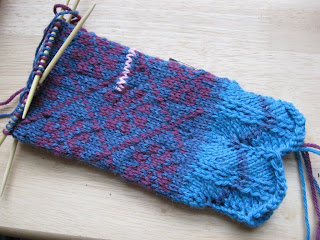A Nice Saturday
Well, to honest, the morning was a bit challenging. This past week the library system migrated to a new platform, and while the basics seem easy to pick up I'm still not entirely fluent with the new one (and there appear to be a few kinks to be worked out). So I was a bit frazzled by the end of my shift.
But it was the Last Saturday of the month, and after work I headed to Madison to join up with the regulars at Victor Allen's. I hadn't been able to make it in months, and it felt really good to get together again. On the way home I stopped off at the Sow's Ear. I had a credit on my loyalty card and it was burning a hole in my pocket/knitting bag. I thought maybe some Kauni, because both Jen and Elizabeth had been using it for entrelac projects that were so pretty. But when I got to the store they had some new Opal colors I couldn't resist.
I don't need more sock yarn, but these were too attractive to pass up. And all my recent projects have been from the stash. Plus that credit paid for half. And I was good and passed over a couple more colors that were almost as appealing to me.
For knitting with the group I brought a simple project (good thing, because for some reason I kept dropping needles and yarn balls and diving under the table to retrieve them. Trying to follow a chart or keep much track of my place in a pattern would have been too much). At home, though, I have started in on, what else?, another pair of mittens.
This is again an Estonian pattern (cat's paw). Since I'm working in heavier yarn (Cascade 220), it has fewer repeats than the sample in the book.




















